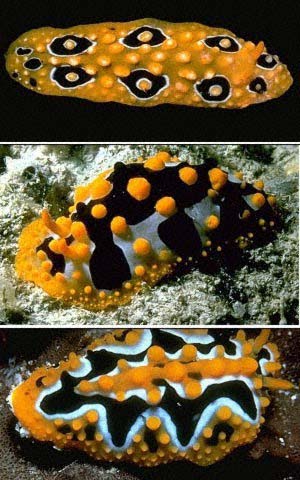
Phyllidia ocellata
Cuvier, 1804
Order: NUDIBRANCHIA
Suborder: DORIDINA
Family: Phyllidiidae
DISTRIBUTION
Common throughout the tropical Indo-West Pacific Ocean, including the Red Sea.
PHOTO
RIGHT - TOP: 22 m depth, Flat Rock, north-east of North Stradbroke Island, southern Qld, 7 Apr. 1981, dorsal view of "typical" specimen, 28 mm, Photo: R.C. Willan (Brunckhorst, 1993: Plate 2D); RIGHT - MIDDLE: collected subtidally, Lucas Island, northern WA, 24 July 1988, dorsal view of 39 mm specimen, Photo: C. Bryce (Brunckhorst, 1993: Plate 2E); RIGHT - LOWER: 20 m depth, Tongue Island, Red Sea, 19 Apr. 1983, dorsal view of P. ocellata undula Yonow, holotype, 18 mm, Photo: N. Yonow (Brunckhorst, 1993: Plate 2F);
BELOW LEFT: TOP: 7-8 m depth, Madang Lighthouse, PNG, 22 Jan. 1988, dorsal view of 30 mm specimen, Photo: R.C.Willan (Brunckhorst, 1993: Plate 2G);
LOWER: 23 m depth, Isle of Pines, New Caledonia, Sept. 1988, dorsal view of 60 mm specimen, Photo: P. Chapman-Smith (Brunckhorst, 1993: Plate 2H);
LOWER RIGHT: 16 m depth, Phi Phi Island, southern Thailand, 5 Dec. 1989, dorsal view of copulating pair; 36 mm (with white rings) and 33 mm (no white) (Brunckhorst, 1993: Plate 3A).
Notes compiled from Brunckhorst, 1993:
The most typical dorsal pattern consists of four to ten black rings bordered in white, each with a central gold or white tubercle. There is little ontogenetic variation in external pattern (i.e., juveniles resemble adults), however considerable individual variation in dorsal pattern occurs in this species. From the basic pattern described, there appear to be numerous related and irregular patterns where the black areas expand and/or meander across the dorsum (Pls 2D-H, 3A). One of these forms was described as "P. ocellata undula" by Yonow (1986). The "undula" form is intermediate in this respect. Some specimens collected in southern Thailand had a dorsum with a mostly black background and yellow tubercles, but little or no white. The first specimen (33 mm live length) was found mating, in situ (16 m depth) with a more "typical" specimen (36 mm live length) (Pl.3A). A third specimen (39 mm) had white borders around some tubercles in the black region (personal observation, 1989).
Phyllidia ocellata can be separated from other predominantly gold-yellow Phyllidia species. It appears to be closest in colour to Phyllidia flava, but P. flava does not have any black pigmentation. Phyllidia varicosa, Phyllidia tula, and Phyllidia coelestis have yellow capped tubercles, but all have blue-grey pigmentation and the former two have a black stripe on the foot sole.
Reference:
• Brunckhorst, D.J. (1993) The systematics and phylogeny of Phyllidiid Nudibranchs (Doridoidea). Records of the Australian Museum, Supplement 16: 1-107.
PHOTOS:
BELOW LEFT: TOP: 7-8 m depth, Madang Lighthouse, PNG, 22 Jan. 1988, dorsal view of 30 mm specimen, Photo: R.C.Willan (Brunckhorst, 1993: Plate 2G); LOWER: 23 m depth, Isle of Pines, New Caledonia, Sept. 1988, dorsal view of 60 mm specimen, Photo: P. Chapman-Smith (Brunckhorst, 1993: Plate 2H);
LOWER RIGHT: 16 m depth, Phi Phi Island, southern Thailand, 5 Dec. 1989, dorsal view of copulating pair; 36 mm (with white rings) and 33 mm (no white) (Brunckhorst, 1993: Plate 3A).
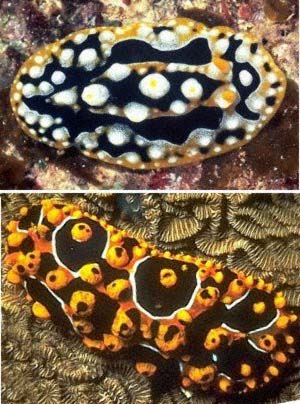

Rudman, W.B., 1999 (January 12) Phyllidia ocellata Cuvier, 1804. [In] Sea Slug Forum. Australian Museum, Sydney. Available from http://www.seaslugforum.net/find/phylocel
Related messages
Re: Is this a variant of Phyllidia ocellata?
December 15, 2009
From: Franca Wermuth
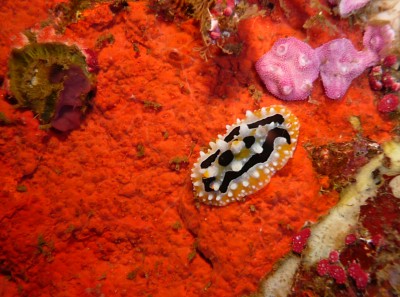
Concerning message #14518:
Dear Bill
I found a very similar one to the Phyllidia ocellata in the above message, but in the Philippines. I'm glad I found this message because I couldn't identify the nudibranch before.
Maybe you could add my little sea slug to your Phyllidia ocellata - collection.
Locality: Camiguin Island, Romblon, Philippine sea, 5. Oct 2008. Length: 5. Oct 2008. Photographer: Franca Wermuth.
Kind regards
Franca
franca.wermuth@gmx.ch
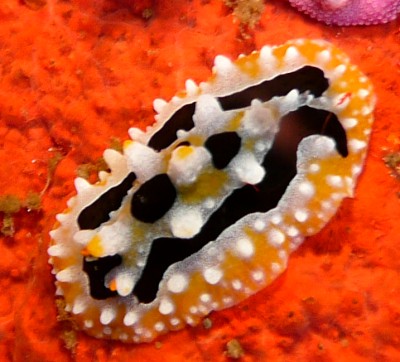
Dear Franca,
This is a nice addition to the P. ocellata story because it also shows a bright red sponge, which is almost certainly its food. If you look at the close-up alongside my reply, you can see a streak of red material at the posterior end of the animal which has just been ejected from the anus - a sure sign that the animal is eating something of the same colour. If you look through earlier messages on the species you will see that this species has been found with very similar-looking red sponges before. The sponge colony seems to form a relatively thin layer over the underlying rock or coral.
Best wishes,
Bill Rudman
Phyllidia ocellata ? from Sulawesi
December 15, 2009
From: Jacques-Yves Phelipot
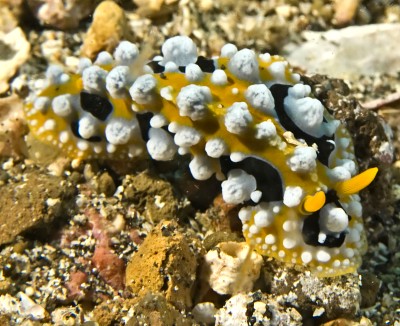
Hi,
Here's a shot of a nudibranch that I took in november in Lembeh. It seems like Phyllidia ocellata but is a little different. Is it a variant of Phyllidia ocellata ?
Locality: Lembeh (Suwalesi), 10m, Indonesia, Indian Ocean, 05 Noveember 2009. Length: 2 cm. Photographer: Jacques-Yves PHELIPOT.
Thanks
Jacques-Yves Phelipot
jacquesyves.phelipot@gmail.com
Phelipot, J.Y., 2009 (Dec 15) Phyllidia ocellata ? from Sulawesi. [Message in] Sea Slug Forum. Australian Museum, Sydney. Available from http://www.seaslugforum.net/find/22947Dear Jacques-Yves,
Yes this is one of the many colour variants of P. ocellata.
Best wishes,
Bill Rudman
Phyllidia ocellata feeding on orange sponge
November 11, 2008
From: Hugues Flodrops

Hi Bill,
Here are two Phyllidia ocellata feeding on the same sponge, who were found by Sandrine Flodrops. I need your help to confirm the genus of this sponge, maybe Tethya?
Locality: Sec Jaune, Saint-Leu, 15 metres, Reunion Island, Indian Ocean, 3 November 2008. Length: 45 and 30 mm. Photographer: Hugues Flodrops.
Thanks and regards.
Hugues.
hugues.flodrops@wanadoo.fr
Flodrops, H., 2008 (Nov 11) Phyllidia ocellata feeding on orange sponge. [Message in] Sea Slug Forum. Australian Museum, Sydney. Available from http://www.seaslugforum.net/find/22020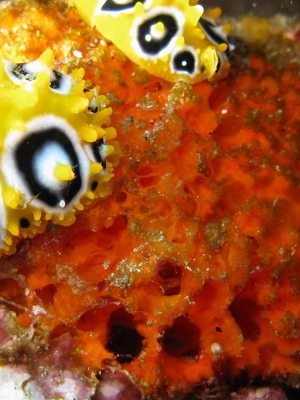
Dear Hugues,
Thanks for the photo. A number of species of phyllidiid have been reported to feed on various species of orange sponge, most of which are members of the Order Axinellida. Unfortunately most sponges are difficult to identify just from photos, especially those with skeletal spicules. Certainly there are species of Tethya which have a similar shape to your sponge colony but I suspect your sponge is encrusting over a dead coral skeleton, and if so its shape is a result of the underlying substrate.
I suspect the sponge is an axinellid, but that's just because P. ocellata has been reported feeding on the orange Higginsia massalis by Dave Brunckhorst (1993).
-
Brunckhorst, D.J. (1993) The systematics and phylogeny of Phyllidiid Nudibranchs (Doridoidea). Records of the Australian Museum, Supplement 16: 1-107.
Best wishes,
Bill Rudman
Phyllidia ocellata from Singapore
October 23, 2008
From: Lior Harari

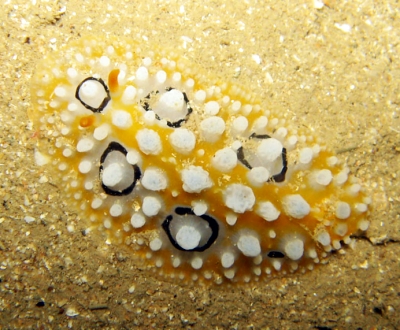
Dear Bill,
I found this one on a dive next to Hantu Island, Singapore.
Locality: Pulau Hantu, About 10 meters, Singapore, South China Sea, 26 August 2007, Silty. Photographer: Lior Harari.
Could you tell me what's its name?
Thank you,
Lior
hararilior@yahoo.com
Harari, L., 2008 (Oct 23) Phyllidia ocellata from Singapore. [Message in] Sea Slug Forum. Australian Museum, Sydney. Available from http://www.seaslugforum.net/find/20601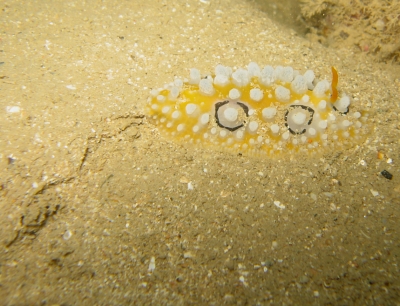
Dear Lior,
I am sure this is a colour form of Phyllidia ocellata. As I have discussed before, Phyllidia babai is almost certainly a white colour form of the same species - and we have a photo on the Forum [message #5458] showing "P. babai" mating with a typically coloured P. ocellata. This colour form, with large diameter black rings seems to be reasonably common in the NW Pacific region Japan, Malyasia and across to Thailand.
Best wishes,
Bill Rudman
Phyllidia ? from the Philippines
August 25, 2008
From: Marcel Tanke

Concerning message #481:
Dear Bill,
Could you please help me to ID this one?
Locality: Anilao, 10-15 m, Philiipines, 8 July 2008. Length: 3 cm. Photographer: Marcel Tanke.
Thanks!
Marcel
marceltanke@cs.com
Tanke, M.A., 2008 (Aug 25) Phyllidia ? from the Philippines. [Message in] Sea Slug Forum. Australian Museum, Sydney. Available from http://www.seaslugforum.net/find/21744Dear Marcel,
Some of these phyllidiids are a problem. As I said in a recent message [#21800] I have problems with P. willani, P. babai and P. exquisita and their relationship to the very variable P. ocellata. Perhaps they are all one species? Your animal has similarities to P. willani but with the patches of yellow background around the edge, I think its best to consider this to be definitely a form of P. ocellata.
Best wishes,
Bill Rudman
Form of Phyllidia ocellata from Mozambique
August 6, 2008
From: Valda Fraser
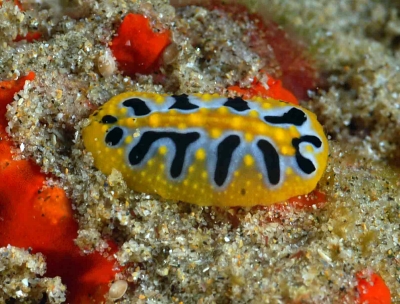
Dear Bill
Recently I photographed this nudibranch. Not too much luck in identifying it. Please help.
Locality: Ponta, 15 m, Mozambique, Indian, 16 June 2008, Reef. Length: 15 mm. Photographer: Valda Fraser.
Regards
Valda
valdafraser@mweb.co.za
Fraser, V.J., 2008 (Aug 6) Form of Phyllidia ocellata from Mozambique. [Message in] Sea Slug Forum. Australian Museum, Sydney. Available from http://www.seaslugforum.net/find/21767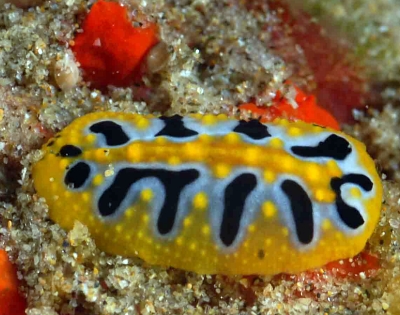
Dear Valda,
This colour form was described as a subspecies of Phyllidia ocellata - P. ocellata undula - but most authors consider it to be just an Indian Ocean colour form of P. ocellata. It is interesting to see it in association with a bright orange-red sponge. We don't know a lot about the different sponges phyllidiids choose to eat, but of the few we know, quite a lot of them, including P. ocellata, have been reported from orange-red species. I don't mean to suggest they prefer a particular coloured sponge, but as all the orange ones so far associated with phyllidiids have belonged to the family Axinellidae, perhaps this sponge is an axinellid as well?
Best wishes,
Bill Rudman
Unknown Phyllididae from the Red Sea
February 22, 2008
From: Véronique Lamare
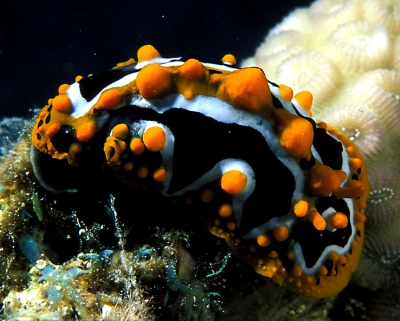
This is an old picture taken in Red sea that I still wonder what type of Phyllididae it can be. I saw recently an other picture from Reunion Island that seems to be the same species. Do you have an idea?
Locality: Siyul Sagira, Egypt, Red sea, 18 July 2000. Length: about 5 cm. Photographer: Véronique Lamare.
Véronique Lamare
verolam38@voila.fr
Lamare, V., 2008 (Feb 22) Unknown Phyllididae from the Red Sea. [Message in] Sea Slug Forum. Australian Museum, Sydney. Available from http://www.seaslugforum.net/find/21229Dear Véronique,
This is a colour form of Phyllidia ocellata found mainly in the western Indian Ocean. There was a proposal consider it to be a subspecies, Phyllidia ocellata undula, but as I discuss on the Fact Sheet, most people consider it to be just a colour variation. Have a look at an earlier message #8365 for photos of some variants from Reunion Is and Mauritius.
Best wishes,
Bill Rudman
Phyllidia ocellata from Vietnam and Thailand
June 14, 2007
From: Asbjorn Hansen

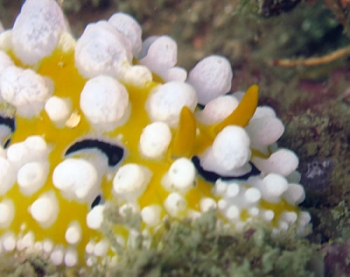
I've was diving for a few weeks now, first in Phu Quoc, Vietnam, and then in Koh Tao, Thailand. I've now seen the same species (or at least I think so) at both places, but I can't figure out what species it is. First I thought it could be some kind of Phyllidiidae but can't find any on your site that looks like this. Hope you can give me some clues.
Locality: Upper Photo: Koh Tao, Thailand, 10 metres, 10 January 2007. Length: 3 cm. Lower Photos: Phu Quoc, Vietnam.. Photographer: Asbjorn Hansen.
Asbjorn Hansen.
asbjorn.hansen@gmail.com
Hansen, A., 2007 (Jun 14) Phyllidia ocellata from Vietnam and Thailand. [Message in] Sea Slug Forum. Australian Museum, Sydney. Available from http://www.seaslugforum.net/find/19267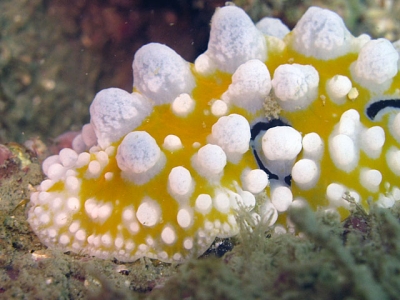
Dear Asbjorn,
These are Phyllidia ocellata. The upper photo from Thailand shpws an extreme colour variant lacking any sign of the black rings or 'ocelli' which give this species its name.
Best wishes,
Bill Rudman
Phyllidia ocellata: 2 forms in one
May 2, 2007
From: Riaan Marx
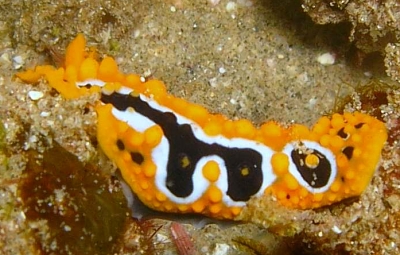
Good morning Bill,
I attached a photo of Phyllidia ocellata that sports 2 colour forms.
Locality: Sodwana, Antons Reef, 18m, South Africa. Indian Ocean, 23 Feb 2007, Rocky reef with sandy patches. Length: 40mm. Photographer: Riaan Marx.
Riaan Marx
rmarx@aasa.co.za
Marx, R., 2007 (May 2) Phyllidia ocellata: 2 forms in one. [Message in] Sea Slug Forum. Australian Museum, Sydney. Available from http://www.seaslugforum.net/find/19558Dear Riaan,
It's always interesting to get colour forms which link supposed species together - in this case P. undula [front half] and P. ocellata [back half].
Best wishes,
Bill Rudman
Phyllidia ocellata from Malaysia
February 6, 2007
From: Charles Rowe

Concerning message #18378:
Hi Bill,
My final one from Sepa Island. I have seen this one on Flickr but it is not identified. We were not sure it even was a nudi until I saw this other photograph. Can you identify it?
Locality: Sepa Island, One Thousand Islands near Jakarta, 12 metres, Indonesia, Ocean, 11 September 2006, Reef slope. Photographer: Charles Rowe.
Charles Rowe
bumff@mweb.co.za
Rowe, C., 2007 (Feb 6) Phyllidia ocellata from Malaysia. [Message in] Sea Slug Forum. Australian Museum, Sydney. Available from http://www.seaslugforum.net/find/18522Dear Charles,
This is Phyllidia ocellata
Best wishes,
Bill Rudman
Mating Phyllidia ocellata
January 26, 2007
From: Richard Swann
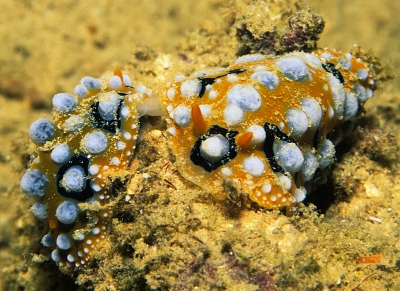
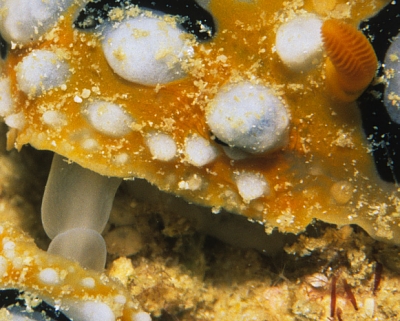
Hi Bill
Its always fascinating to see mating behavior so I thought I would share a few images with you. I photographed these two Phyllidia ocellata on the fringing reef of Mamutik island at 11 m just as it meets the sandy substrate. Any interesting comments are always welcome.
Locality: Mamutik island,Kota Kinabalu, 11meters, Sabah, Borneo, south China Sea, 9th January 2007, Sheltered fringing reef. Length: Largest one 3cm. Photographer: Richard Swann.
Thanks for all your efforts
Richard Swann
richard@downbelow.co.uk
Swann, R., 2007 (Jan 26) Mating Phyllidia ocellata. [Message in] Sea Slug Forum. Australian Museum, Sydney. Available from http://www.seaslugforum.net/find/19254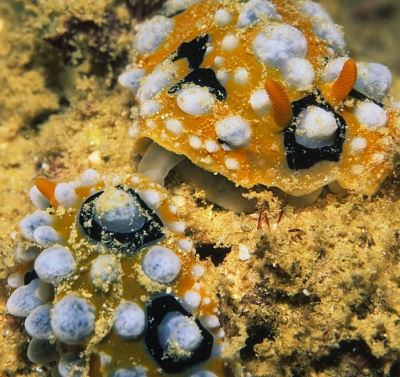
Dear Richard,
It's good to get photos of mating pairs, especially in species with considerable colour variation, because there is always the chance that such observtions will give us some clues to just what is a species and what is not. Unfortunately in this case I really haven't any interesing comments as both seem to be of the same colour pattern.
Best wishes,
Bill Rudman
Phyllidia 'undula' from the Red Sea
September 7, 2005
From: Kamal El Tawil
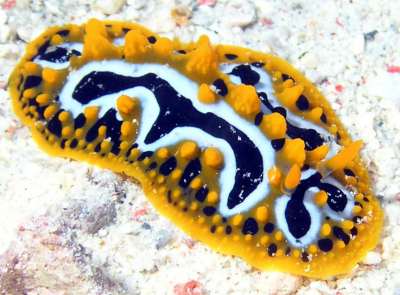
Dear Bill:
Another picture - Phyllidia undula on sandy bottom .
Locality: Yolanda reef, Ras Mohamed, Sinai, Egypt - Red Sea. Depth: 18 metres. Length: approx 4 cms. 22 July 2005. Photographer: Kamal el Tawil
Regards
Kamal
kt@tedata.net.eg
El Tawil, K., 2005 (Sep 7) Phyllidia 'undula' from the Red Sea. [Message in] Sea Slug Forum. Australian Museum, Sydney. Available from http://www.seaslugforum.net/find/14692Thanks Kamal,
Phyllidia undula is now considered just a colour form of the very variable Phyllidia ocellata. But it is still important to record some of the colour forms and their geographic distribution, because in truth, we know very little about the variation and biology of any of the phyllidiids
Best wishes,
Bill Rudman
Is this a variant of Phyllidia ocellata?
August 13, 2005
From: Sue Griffith
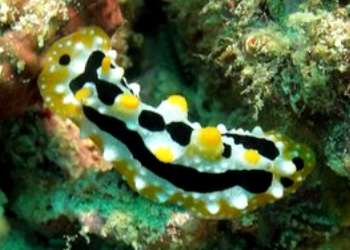
I've searched in various books and on websites to try and identify the attached nudibranch. It has the coloration of Phyllidian ocellata but does not have any ocellations. It looks somewhat like Phyllidia exquisita, although the coloration didn't really match any photos I found of this species.
Locality: Mabul Island, Malaysia (Borneo) Celebes Sea. Depth: ~50 feet. Length: ??approx. 3-4 cm. May 2005. Reef. Photographer: Sue Griffith
I'd be grateful for an expert's opinion!
Many thanks,
Sue Griffith.
2emailsue@gmail.com
Griffith, S, 2005 (Aug 13) Is this a variant of Phyllidia ocellata?. [Message in] Sea Slug Forum. Australian Museum, Sydney. Available from http://www.seaslugforum.net/find/14518Dear Sue,
I hesitate to assume the mantle of an 'expert'. The more I look at phyllidiids, the more I realise we still have a lot to learn. An animal from Madang, Papua New Guinea which looks very like yours was identified by Brunckhost (1993) as P. ocellata, but most specimens do not have a black median band on the mantle like yours - and Phyllidia exquisita doesn't have such a band. If it is P. ocellata it suggests the species ranges from typical animals with black rings or ocelli, through forms such as 'P. ocellata undula' with a wavy black line down each side of the mantle, to forms such as yours.
It is an interesting addition to the puzzle
Best wishes,
Bill Rudman
Two colour forms of Phyllidia ocellata
March 3, 2005
From: Riaan Marx
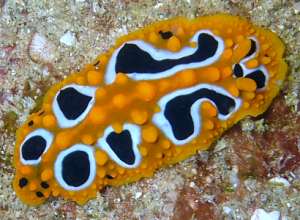
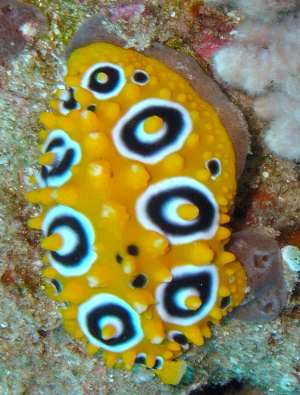
Dear Dr. Rudman,
I thought you might enjoy these two pictures of Phyllidia ocellata. I found both these color forms on the same reef. They were about 15m apart, but the depth was similar.
Locality: Ponta Malongane, Mozambique, Indian Ocean. Depth: 13 metres. Length: 40 mm. 8 February 2005. Rocky/sandy reef. Photographer: Riaan Marx
Kind regards,
Riaan Marx.
v-riaanm@microsoft.com
Riaan Marx, 2005 (Mar 3) Two colour forms of Phyllidia ocellata. [Message in] Sea Slug Forum. Australian Museum, Sydney. Available from http://www.seaslugforum.net/find/13235Thanks Riaan,
The lower photo is a bit tantalising as it looks like the animal may be eating the sponge it is sitting on. But I can't see enough of the sponge to hazard an identification
Best wishes,
Bill Rudman
Phylldia ocellata from Rottnest Is, W. Australia
March 18, 2004
From: Chris Cunnold
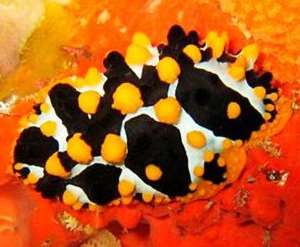
Dear Bill,
This photo by Matthew Dwyer of Underwater Explorers Club in Western Australia was taken recently at Rottnest Island [off Perth, WA]. A West Australian reference I have names it as Phyllidiella nigra and states there has only been one photographic record of it in Western Australia. After referring to this site, I have my doubts.
What do you think?
Chris Cunnold
cunnold@iinet.net.au
Cunnold, C., 2004 (Mar 18) Phylldia ocellata from Rottnest Is, W. Australia. [Message in] Sea Slug Forum. Australian Museum, Sydney. Available from http://www.seaslugforum.net/find/12476Dear Chris,
This is a colour form of Phyllidia ocellata. There is a photo on the Fact Sheet of an animal from Lucas Island, northern Western Australia, which looks very similar. I can't see any similarity it has to Phyllidiella nigra.
Cheers
Bill Rudman
An ocellate 'Phyllidia undula' from Red Sea
July 26, 2003
From: Chris Quinn

I saw this nudibranch/flatworm on the wreck of the Thistlegorm in the Red Sea at a depth of about 25m. Water temp was 24c, and the beast in question was about 2-3cm long.
Can anyone identify it?
Chris Quinn
chris.quinn@zoom.co.uk
Dear Chris,
This is Phyllidia ocellata. It is quite variable in colour and this Red Sea colour form has been considered to be a distinct species with the name Phyllidia undula, but if you look through the photos of this species on ther Forum you will see the colour forms merging into one another. In fact your animal in which the black patches on each side are breaking up into spots surrounded by a whitish ring is an excellent example of how this Red Sea form merges into those with spots and rings
Best wishes,
Bill Rudman
Phyllidia ocellata from Taiwan
July 7, 2003
From: Todd Garthwaite
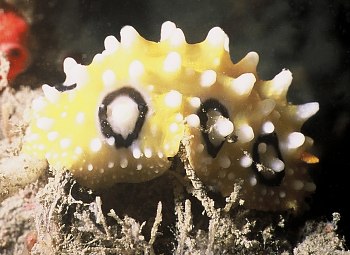
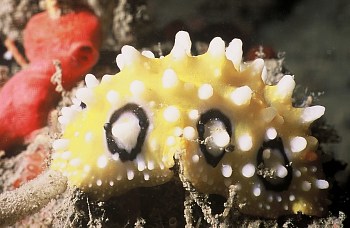
Hi Bill,
I believe I have several shots of a Phyllidia ocellata to add to the Forum. I came across this specimen in an area rich in gorgonian sea fans and soft coral.
Site: BaDouZi, (N.E. Coast, Taipei County, Taiwan), 24 May 2003, 10:25am
Depth: 23.7 meters. Water temperature: 24 deg. Celsius. Size: approximately 50+ mm.
Stay golden.
Peace, love, & nudis
Todd Garthwaite
typhoontoddy@yahoo.com
Garthwaite, T., 2003 (Jul 7) Phyllidia ocellata from Taiwan. [Message in] Sea Slug Forum. Australian Museum, Sydney. Available from http://www.seaslugforum.net/find/10216Thanks Todd,
Bill Rudman
Phyllidia ocellata from the Solomon Ids
April 25, 2003
From: Bruce Potter
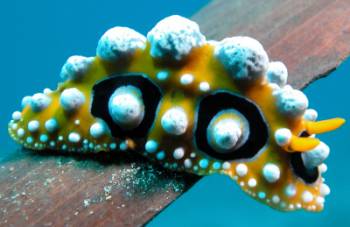
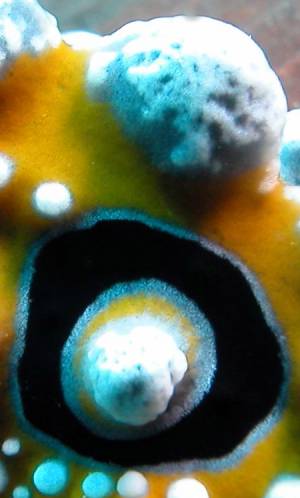
Dear Bill,
I came across this Phyllidia ocellata yesterday [21 April 2003]. These are relatively common here, but I am sending it because I like the photo.
It was about 25mm long, and at about 16 meters deep on a coral and rubble site just on the outskirts of Honiara, Solomon Islands.
Regards
Bruce Potter
bruce.potter@adventist.org.sb
Thanks Bruce,
I've included a close-up to show the pigment granules
Bill Rudman
Phyllidia ocellata from Fiji
February 28, 2003
From: Richard Perry

First trip to the S. Pacific I found this guy. Bequa Island, Fiji .... Any help in identifying him? (One comedian on another forum called it the Mr. Bill Nudi) ... looking for a little more than that.
Richard Perry
rperry@tioloco.com
Perry, R., 2003 (Feb 28) Phyllidia ocellata from Fiji. [Message in] Sea Slug Forum. Australian Museum, Sydney. Available from http://www.seaslugforum.net/find/9105Dear Richard,
This is Phyllidia ocellata. If you look at the other messages on the Phyllidia ocellata page you will see that the colour of this species is a very variable, but it usually has black spots with a white ring which give it the name ocellata which means 'eyespots'.
Best wishes,
Bill Rudman
Phyllidia ocellata colour forms mating
February 26, 2003
From: Vinka Stenhouse

Bill
Thought these two colour variations of Phyllidia ocellata mating may be of interest.
Seen at a depth of 15 metres. Santo, Vanuatu. March 2002.
Vinka Stenhouse
vinkas@oceanaphotography.com
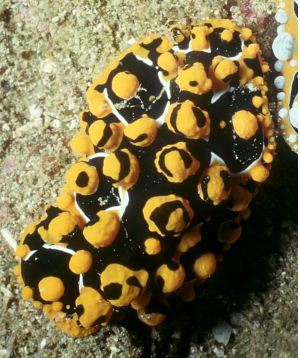
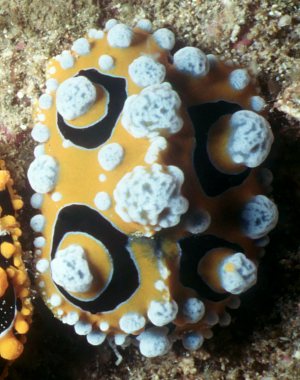
Thanks Vinka,
Photos like this make the Forum very worthwhile. Finding mating pairs in nature is not that common and finding quite different colour variants mating is definitely an uncommon event. By utilising the eyes - and cameras - of all you interested amateurs and divers, we are all getting an enormous amount of new information about these fascinating animals
Best wishes,
Bill Rudman
Phyllidia ocellata from Pemba
November 21, 2002
From: Paul Young
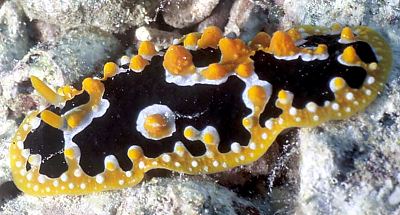
Dear Bill,
Here is another of the nudibranchs that Charlotte and I found at Pemba Island, off the coast of Tanzania, western Indian Ocean, in November/December 2001. This one was photographed on the 23 November, near Fundu Lagoon, West side of Pemba. We did this dive with the Fundu Lagoon Resort to small nearby islands.
Best wishes,
Paul Young
young@underwater.org
Young, P., 2002 (Nov 21) Phyllidia ocellata from Pemba. [Message in] Sea Slug Forum. Australian Museum, Sydney. Available from http://www.seaslugforum.net/find/8418Dear Paul,
This is a colour form of Phyllidia ocellata in which the black pigmentation which forms rings in the 'ocellate' form, dominates, giving the mantle a black background colour.
Best wishes,
Bill Rudman
'undula' form of Phyllidia ocellata
November 10, 2002
From: Marina Poddubetskaia
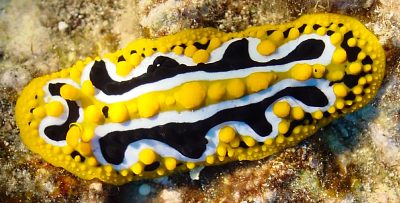
Dear Bill,
Here are some photos of Phyllidia ocellata undula I found this colour form both in Reunion and Mauritius. It seems that we can't say any more that Phyllidia ocellata undula is endemic to the Red Sea.
Upper Right, Lower Left: October 10, 2002
Location: St-Leu, Reunion Island, Indian Ocean. Site: Les arches. Depth: 6m. Size: 45-50mm
Lower Right: October 13, 2002. Location: Pereybere, Mauritius, Indian Ocean. Site: Anemone Garden. Depth: 19m. Size: 50-55mm
Photos: Marina Poddubetskaia - Nembro website
Best wishes,
Marina.
nembro@nembro.info
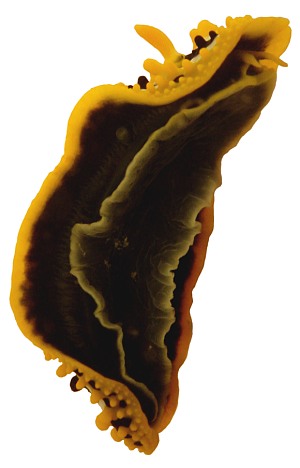

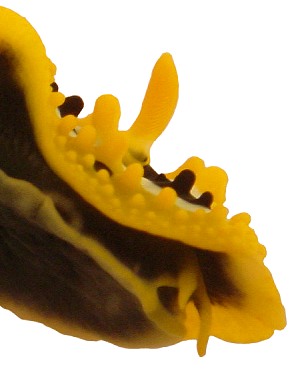
Thanks Marina,
Most people consider P. ocellata undula as a colour variant rather than as a subspecies. As you show in the dorsal photos of the specimens from Reunion and Mauritius, the black markings down each side range from a complete undulating black wave to a broken wave, and then gradually through black spots, to the black rings shown in your other message. There is a nice cryptic little copepod between the rhinophores in the lower right photo.
I have included an enlargement showing the head. Both phyllidiids and dendrodorids have a distinctive arrangement in which flaps of skin on each side of the mouth join on to the anterior edge of the foot to form a pocket or pit in which the mouth opens. It probably has some function in their suctorial feeding, perhaps to enclose the digestive secretions from the oral glands during the process of externally breaking down their sponge food, but as far as I know no one has studied this aspect of their feeding.
Rudman, W.B., 2002 (Nov 10). Comment on 'undula' form of Phyllidia ocellata by Marina Poddubetskaia. [Message in] Sea Slug Forum. Australian Museum, Sydney. Available from http://www.seaslugforum.net/find/8365P. ocellata: 3 colour forms in Mauritius
November 10, 2002
From: Marina Poddubetskaia
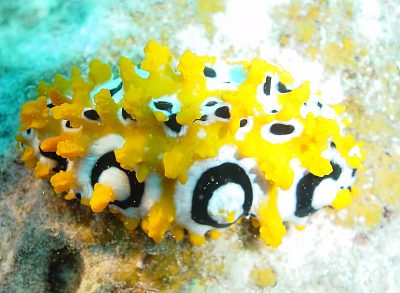
Dear Bill,
In Mauritius I found these 3 colour forms of Phyllidia ocellata co-existing. And the first two animals were found in the same diving site.
Upper: October 13, 2002
Location: Pereybere, Mauritius, Indian Ocean. Site: Anemone Garden. Depth: 18m. Size: 65-70mm
Lower Left: October 13, 2002
Location: Pereybere, Mauritius, Indian Ocean. Site: Anemone Garden. Depth: 19m. Size: 50-55mm
Lower Right: October 17, 2002
Location: Pereybere, Mauritius, Indian Ocean. Site: Gaetan Patchers. Depth: 16m. Size: 40-45mm
Photos: Marina Poddubetskaia - Nembro website
Best wishes,
Marina.
nembro@nembro.info
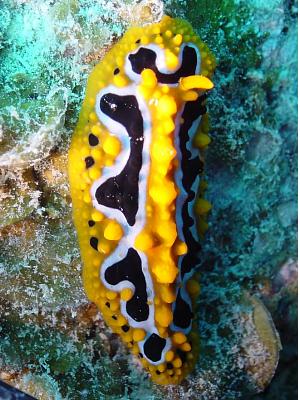
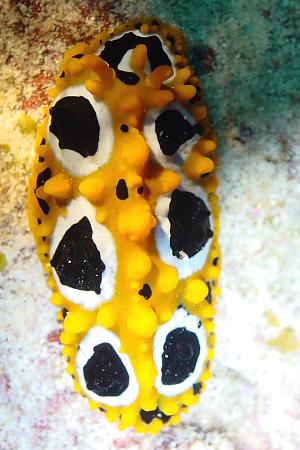
Thanks Marina,
I think with P. ocellata it's probably better to talk of colour 'variants' rather than 'forms'. To me the word 'form' is similar to 'morph' which is a term we use for a defined and distinct colour pattern, specially when you talk of co-existence, which suggests a number of distinct genetic entities. I think with P. ocellata we have a very variable species and the three illustrated here are part of a continuum.
Best wishes,
Bill Rudman
Phyllidia ocellata? colour form
September 27, 2002
From: Bruce Potter
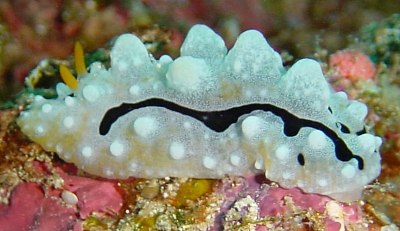
Dear Bill,
On last weekends trip to the Russell Islands, in the Solomon Islands, I came accross this slug on the site called Karumolun. It was about 30mm long, in about 12 metres of water.
Is this just a very uncolourful Phyllidia ocellata, or something else?
Regards
Bruce Potter.
bruce.potter@adventist.org.sb
Potter, B., 2002 (Sep 27) Phyllidia ocellata? colour form. [Message in] Sea Slug Forum. Australian Museum, Sydney. Available from http://www.seaslugforum.net/find/7934Dear Bruce,
I would agree that this is a very uncoloured form of Phyllidia ocellata. I must say I have never seen one quite this pale before.
best wishes,
Bill Rudman
Phyllidia ocellata from Egypt
September 26, 2002
From: Michael Mrutzek
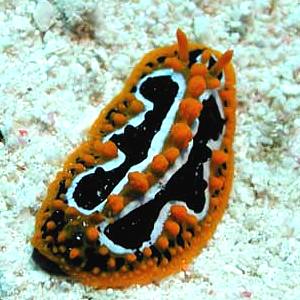
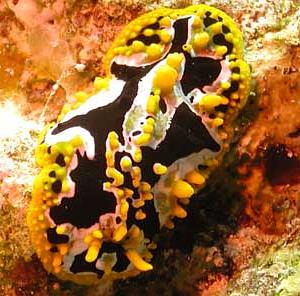
Dear Bill,
Here is another slug from the Red Sea.
Data:
Upper: Reef off Hurghada, Red Sea coast of Egypt, August, 2002, 30 meters.
Lower: Near Carles Reef, midday, 20 meters deep, off Hurghada, August, 2002. Photos: Copyright Michael Mrutzek
Michael
Mrutzek@meeresaquaristik.de
Mrutzek, M., 2002 (Sep 26) Phyllidia ocellata from Egypt. [Message in] Sea Slug Forum. Australian Museum, Sydney. Available from http://www.seaslugforum.net/find/8039Thanks Michael,
This is another phyllidiid. It is named Phyllidia ocellata after the rings found in the colour pattern of many animals. However in this colour form, which seems to be common in the Red Sea, the rings coalesce to form an undulating wave-like pattern. Yonow (1986) considered this to be distinct enough to erect a subspecies Phyllidia ocellata undula, but this has not been accepted by most workers.
Best wishes,
Bill Rudman
Phyllidia ocellata in Solomon Islands
July 7, 2002
From: Rachel Murphy
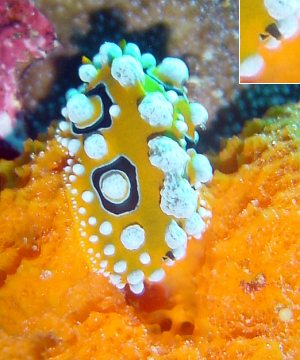
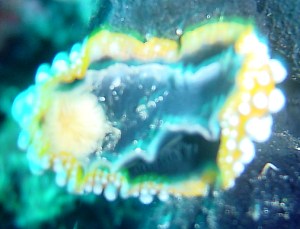
Hi Bill
I've been an avid follower of your website for some years and finally have been able to beg, borrow and steal for a suitable camera to take nudibranch pictures. I took these pictures of Phyllidia ocellata feeding on an orange sponge. The divesite was Top Shelf, Munda, Solomon Islands, 25/4/02, depth 27m, water temp 28C.
Was wondering if it is defecating in first image?
Rachel Murphy
nudinut@hotmail.com
Murphy, R., 2002 (Jul 7) Phyllidia ocellata in Solomon Islands. [Message in] Sea Slug Forum. Australian Museum, Sydney. Available from http://www.seaslugforum.net/find/7419Dear Rachel,
I am glad you could get hold of a camera and take the photo of P. ocellata on its food sponge. I have included an enlarged view of the bit you thought might be a faecal pellet. I am pretty sure it is the anal papilla. Often we call the hole we can sometimes see on the back of these animals the anus. However in most species I have seen alive the anus is at the end of a tube which usually sits retracted into a small cavity on the back of the animal. Only when the animal is defecating does it extend the tube out of this little pocket. I guess its a way of protecting it from being nipped off by an inquisitive, or hungry, fish. So yes it probably is defecating but what you can see is the not a faecal pellet but the extended anal tube or papilla.
Thanks also for the ventral (underside) shot. Some P. ocellata are essentially black like this while others are yellow. I don't know if that will prove significant, but it is certainly good to build up some information s we can see if there is any correlation between dorsal and ventral colour patterns.
Best wishes,
Bill Rudman
Variation in Phyllidia ocellata
July 2, 2002
From: Bernard Picton
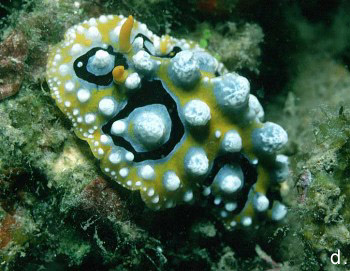
Hi Bill,
I've noticed that Phyllidia ocellata in Indonesia [Photo d] looks quite different from those I've seen in East Africa and the Red Sea. I wonder if there is some geographic variation here (ie. subspecies) or if in fact there are several species in the P. ocellata complex. These Pemba Is. ones [Photos a-c] show the variation between Yonow's P. o. undula and 'typical' P. ocellata to be continuous within one population though.
Upper Right: March 1996 - Bali, Indonesia.
Lower Left, Right: Feb 1999 - Pemba Is., East Africa. PHOTOS: B.E.Picton.
Bernard
bernard.picton.um@nics.gov.uk
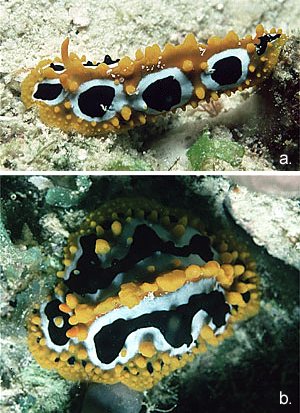
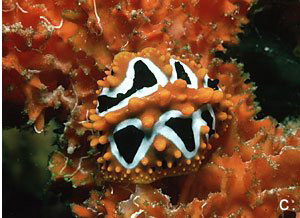
Thanks Bernard,
Quite an interesting series. Perhaps the animals with a tuberculate ridge down the dorsal midline, including 'P. undula' will turn out to be a distinct species. My problem has been that 'revisions' have been based on so few animals and so few characters. And there are also the 'satellite' species such as P. babai. Yasuhiro Shirai's photo of probable P. babai and P. ocellata mating certainly suggests we don't know the full story as yet. The animal on the orange sponge is another nice feeding indication. I don't suppose we could be so lucky as to find they have different feeding preferences.
Cheers,
Bill Rudman
Phyllidia ocellata from Malaysia
June 17, 2002
From: Kheong Sann Chan
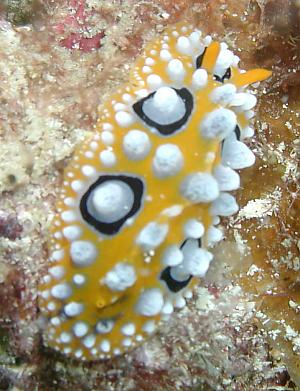
Dear Bill,
Here is another photo from Pulau Dayang off the east coast of west Malaysia.
Location: Dayang, Pinnacles
Date : 8 June, 0800
Depth : 15m
Kheong Sann Chan
kschan@mail.dsi.nus.edu.sg
Chan, K.S., 2002 (Jun 17) Phyllidia ocellata from Malaysia. [Message in] Sea Slug Forum. Australian Museum, Sydney. Available from http://www.seaslugforum.net/find/7254Thanks Kheong,
This is Phyllidia ocellata.
Best wishes,
Bill Rudman
Phyllidia ocellata from the Red Sea
April 25, 2002
From: Marina Poddubetskaia

Dear Bill,
Here is another photo from my visit, at the end of March, to Egypt. It was a dive cruise at the North of Red Sea, between Hurghada and Sinai mountains. I have identified this as Phyllidia ocellata.
Approx 6cm, 22 March 2002, "Siyul Kebira" / North Red Sea, 18m depth
Best wishes,
Marina.
marina.poddubetskaia@francetelecom.com
Poddubetskaia, Marina. , 2002 (Apr 25) Phyllidia ocellata from the Red Sea. [Message in] Sea Slug Forum. Australian Museum, Sydney. Available from http://www.seaslugforum.net/find/6726Dear Marina,
Yes this is Phyllidia ocellata. It was described as a subspecies P. ocellata undula by Yonow (1986), but that distinction has not been accepted by most authors.
Best wishes,
Bill Rudman
Phyllidia ocellata from Malaysia
April 22, 2002
From: Kheong Sann Chan
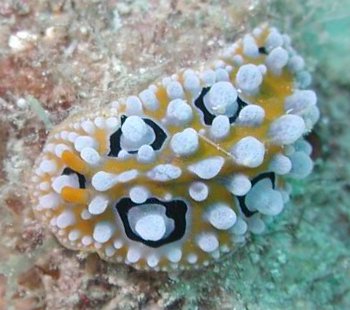
Hi Dr. Rudman,
Here is another nudibranch I photographed recently at Pulau Dayang off the East Coast of Malaysia. Depth varied approximately 15-23m deep [13 April 2002].
Kheong.
kschan@mail.dsi.nus.edu.sg
Sann Chan, K., 2002 (Apr 22) Phyllidia ocellata from Malaysia. [Message in] Sea Slug Forum. Australian Museum, Sydney. Available from http://www.seaslugforum.net/find/6775Dear Kheong,
This is Phyllidia ocellata. If you look at the information on this species, and other messages on the Forum you will see it is very variable in colour.
Best wishes,
Bill Rudman
Phyllidia ocellata from Japan (2)
January 14, 2002
From: Yasuhiro Shirai
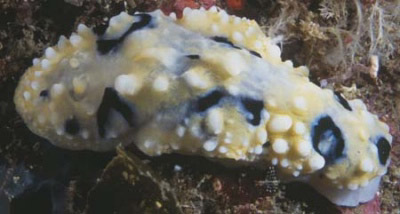
Dear Bill,
I found this animal at the rocky reef of Kii Peninsula, Middle Japan, on 24th June, 2001. Although this one is like as Phyllidia ocellata, both of mantle and rhinophores were pale yellow and border line between yellow and white zone is quite obscure.
Is this P.ocellata or another species?
Length: 50mm
Depth: 15m
Water temperature: 19 degrees
Yasuhiro Shirai
yasuhiro@sea-slug.com
Shirai, Y., 2002 (Jan 14) Phyllidia ocellata from Japan (2). [Message in] Sea Slug Forum. Australian Museum, Sydney. Available from http://www.seaslugforum.net/find/5459Dear Yasuhiro,
As I said in answer to your other message, the colour variation found in this species seems to be very large but trying to separate the colour forms into a number of stable colour patterns which don't merge with others doesn't seem possible at present. Even Brunckhorst's species Phyllidia babai and Phyllidia willani appear to have 'forms' which are difficult to separate from forms of P. ocellata.
It is possible your animal has suffered considerable damage - perhaps been swallowed and regurgitated by a fish?
Best wishes,
Bill Rudman.
Phyllidia ocellata from Japan (1)
January 14, 2002
From: Yasuhiro Shirai
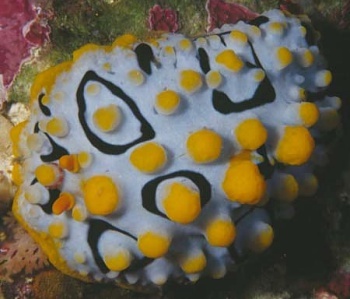
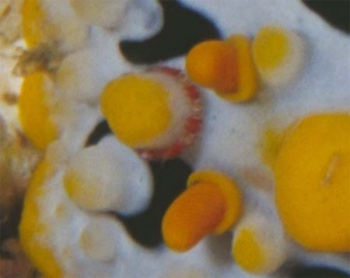
Dear Bill,
I found this Phyllidia ocellata at the rocky reef off Kushimoto, middle of Japan, on 25th April, 2000. This animal had something like a ring around the tubercles at the front of the rhinophores.
Do you know what it is? A parasite?
Length: 60mm
Depth: 15m
Water temperature: 17 degrees
Sincerely,
Yasuhiro Shirai
yasuhiro@sea-slug.com
Shirai, Y., 2002 (Jan 14) Phyllidia ocellata from Japan (1). [Message in] Sea Slug Forum. Australian Museum, Sydney. Available from http://www.seaslugforum.net/find/5460Dear Yasuhiro,
This is indeed a strange colour form of P. ocellata. I still think we have some work to do to sort out this group of animals with black rings around the tubercles. The coloured band around the tubercle is a bit puzzling. It seems to have segments on it so it is possibly a polychaete worm, either just having a rest, or perhaps living on the nudibranch.
Best wishes,
Bill Rudman.
Phyllidia ocellata from Tufi, PNG
October 18, 2001
From: Des Paroz

Hi Bill
Attached are three photos of a striking Phyllidia ocellata I found at the Tufi Wharf "muck dive", Papua New Guinea, September 2001. Actually found this critter almost every dive at this site over a period of about 8 days - it was always within a metre or 2 of the same spot.
Depth was 7-8m, and was in an area with a lot of human debris, little water movement, and a really healthy range of small critters. A great muck dive.
Water temp was consistently 28C.
Best regards
Des
des@paroz.com


Thanks Des,
The bottom two photos show the animal with its head over a colony of something. I suspect it is a compound ascidian colony rather than a sponge, so it is unlikely to be its food. Any observations on feeding during your week?
Cheers,
Bill
Phyllidia ocellata & P. babai mating?
October 14, 2001
From: Yasuhiro Shirai
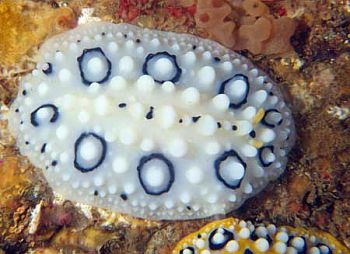
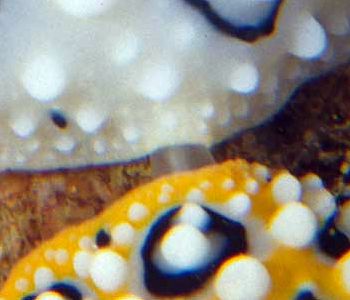
Dear Bill,
I found this animal at the rock reef of Kii Peninsula, middle of Japan, on 7th Nov. 1999.
This white Phyllidia ocellata which looks quite like P.babai, was mating with typical yellow P. ocellata.
Sometimes I can't understand the difference of P. ocellata from P. babai.
Length:60mm
Depth:16m
Water temperature: 22 degrees
Sincerely,
Yasuhiro Shirai
yasuhiro@sea-slug.com
Shirai, Y., 2001 (Oct 14) Phyllidia ocellata & P. babai mating?. [Message in] Sea Slug Forum. Australian Museum, Sydney. Available from http://www.seaslugforum.net/find/5458Dear Yasuhiro,
What an interesting photo. I have been uncomfortable about P. babai since it was described by Brunckhorst (1993). Since then I have found many animals I have great difficulty in identifying.
Your photo suggests to me that P. babai is a pale colour variant of P. ocellata.
I would be interested in hearing other opinions on this.
Best wishes,
Bill Rudman
Phyllidia ocellata feeding
September 13, 2001
From: Leslie Chan
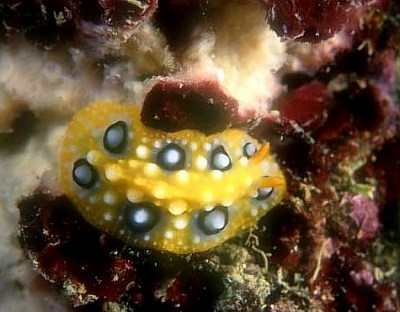
Dear Dr. Rudman
Thank you very much your prompt reply. Attached is a photo showing more of the sponge Phyllidia ocellata was feeding on. It was taken on 27 May 2001.
Best regards
Leslie
leslie@marinelife.com.hk
Chan, L., 2001 (Sep 13) Phyllidia ocellata feeding. [Message in] Sea Slug Forum. Australian Museum, Sydney. Available from http://www.seaslugforum.net/find/5261Thanks Leslie,
I can't identify the sponge from your photo but it gives us a colour and shape to look out for.
I know of two feeding records: •Brunckhorst (1993) reports it feeding on a dark orange-red sponge, Higginsia massalis Carter, 1889 [Axinellida: Desmoxyidae]
•Avila (1995) cites a report of it feeding on Acanthella cf. cavernosa.
Best wishes,
Bill Rudman
Phyllidia ocellata from Hong Kong
September 4, 2001
From: Bill Rudman & Brian Darvell
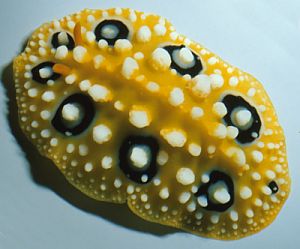
Here is some information and photos on Phyllidia ocellata from Brian Darvell's Hong Kong collections.
PHOTO: North Ninepin, Hong Kong, 15-18m. 15 July 1984. AM C142950. Photo: B.W.Darvell
Hong Kong Collection Records: AM C135250, Gau Tau, 8m, 23 May 1982; AM C135251, East Basalt Is, 8m, 6 June 1982; AM C142950, North Ninepin Island, 15-18m. 15 July 1984; AM C153327, South Ninepin Island, 13m, 3 May 1987.
Best wishes,
Bill Rudman & Brian Darvell
Phyllidia ocellata from Hong Kong
September 3, 2001
From: Leslie Chan
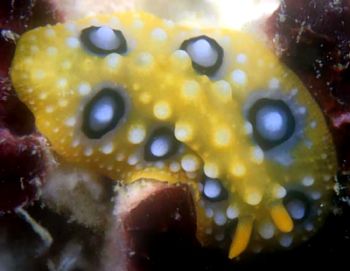
Dear Dr. Rudman
Could you please ID this nudibranch from Hong Kong?
It is feeding on sponge. 8m depth . Steep Island. [27 May 2001].
Thank you very much
Best regards
Leslie
www.marinelife.com.hk
leslie@marinelife.com.hk
Chan, L., 2001 (Sep 3) Phyllidia ocellata from Hong Kong. [Message in] Sea Slug Forum. Australian Museum, Sydney. Available from http://www.seaslugforum.net/find/5201Dear Leslie,
This is another colour form of Phyllidia ocellata. As with other very variably coloured species there is always a doubt that we may instead have a group of distinct species each slightly different in colour. So information on such things as their food sponges and egg masses is always interesting to have, just in case we find consistent differences between different colour patterns and food or egg mass. If by chance you have a photo which shows the sponge more clearly it would be a useful additional piece of information. And if possible can you give me a date when you took the photo.
Best wishes,
Bill Rudman
Unusual color pattern in Phyllidia ocellata
September 2, 2001
From: Mary Jane Adams
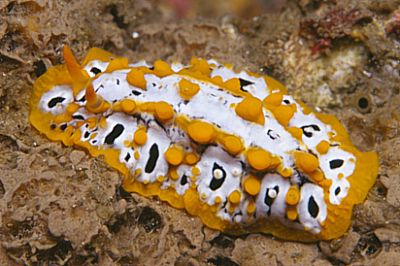
Hi Bill
I didn't recognize this slug when I first saw it. After studying my photographs, I think it is Phyllidia ocellata with an unusual color pattern. I saw a lot of P. ocellata in the Lembeh Straits. All of them had the typical western Pacific pattern except this one. Length: 23 mm, Depth: about 10 meters.
Divesite: Magic Cracks, Lembeh Straits, Sulawesi, Indonesia, Aug. 12, 2001.
Best regards,
Mary Jane
divepng@yahoo.com
Adams, M.J., 2001 (Sep 2) Unusual color pattern in Phyllidia ocellata. [Message in] Sea Slug Forum. Australian Museum, Sydney. Available from http://www.seaslugforum.net/find/5187Thanks Mary,
I would agree that this is a colour form of P. ocellata.
Bill Rudman
Phyllidia ocellata and mimic from Mozambique
June 10, 2001
From: Kirsty Miller

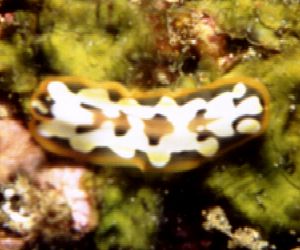
Dear Bill
I found these nudibranchs on coral reefs depth 18 m at Ponta Malongane in Southern Mozambique. Size is 3 cm. I think they both are Phyllidia ocellata. Could you please help me with an ID
Thanks
Kirsty Miller
divegirl@xsinet.co.za
Miller, K., 2001 (Jun 10) Phyllidia ocellata and mimic from Mozambique. [Message in] Sea Slug Forum. Australian Museum, Sydney. Available from http://www.seaslugforum.net/find/4499Dear Kirsty,
Your upper photo is certainly P. ocellata. It is the colour form that Nathalie Yonow nameed as the subspecies P. ocellata undula. The lower photo is quite interesting as I am pretty sure it is a flatworm, perhaps of the genus Pseudoceros. Many flatworms are very brightly coloured and are often mistaken for nudibranchs. Some flatworms appear to mimic certain species of nudibranch, which may be the case here. You can see at the left end of the animal in your lower photo that the dge of the body has two high folds which in these flatworms act as tentacles.
Best wishes,
Bill Rudman
Phyllidia ocellata from Madagascar
January 30, 2001
From: Leif Abrell
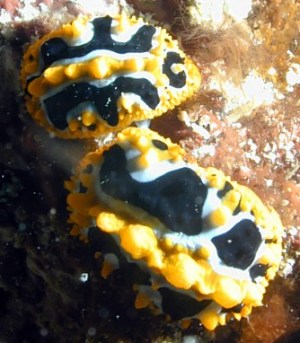
Dear Bill,
Here is a photo of Phyllidia ocellata which I took in NW Madagascar in April, 2000.
Photos of the other opisthobranchs from Madagascar can be seen at http://www.columbia.edu/~la202/Mad-opisth2000.html
Leif
lagartica@hotmail.com
Abrell, L., 2001 (Jan 30) Phyllidia ocellata from Madagascar. [Message in] Sea Slug Forum. Australian Museum, Sydney. Available from http://www.seaslugforum.net/find/3570Thanks Leif,
This is very similar to the colour form Nathalie Yonow (1986) described as a subspecies P. ocellata undula from the Red Sea, but just seems to be a colour form of a very variable species.
Bill Rudman
Colour variation in Phyllidia ocellata
January 1, 2001
From: Yasman
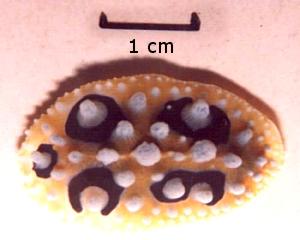
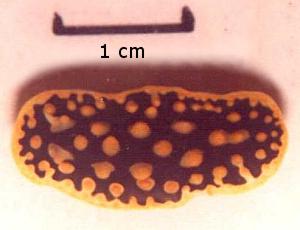
Dear Bill,
I am very sure that the first picture (above) is Phyllidia ocellata. But I am not quite sure whether the second picture (below) is also Phyllidia ocellata?? What do you think?
Regards,
Yasman
y.yasman@mailcity.com
Yasman, 2001 (Jan 1) Colour variation in Phyllidia ocellata. [Message in] Sea Slug Forum. Australian Museum, Sydney. Available from http://www.seaslugforum.net/find/3342Dear Yasman,
Yes these are both considered to be colour forms of P. ocellata.
Bill Rudman
Phyllidia? from Thailand
December 27, 2000
From: Dave Harasti
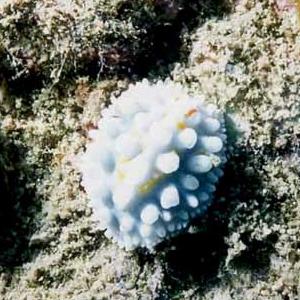
Bill,
Can you help identify this nudibranch for me(is it actually a nudibranch? The photo was taken in late October 2000.
It was found off the island of Koh Tao in Thailand in about 10 metres of water sitting on a wall. I didn't see it move at all. I have had no luck in identifying it, no books seem to have anything like it.
Thanks,
Dave Harasti
http://www2.dynamite.com.au/davidh/index.htm
davidh@dynamite.com.au
Harasti, D., 2000 (Dec 27) Phyllidia? from Thailand. [Message in] Sea Slug Forum. Australian Museum, Sydney. Available from http://www.seaslugforum.net/find/3366Dear Dave,
Since I have a bit of a backlog at the moment I have the luxury of being able to match up messages dealing with the same or similar animals. Have a look at Vincent Tomeno's message which I am also posting today which is probably the same species? or colour form. Looking at the yellow rhinophore visible in your photo I am pretty convinced it is an almost colourless form ofPhyllidia ocellata, but of course the animal, when someone has the opportunity to study it, may prove me quite wrong.
Best wishes,
Bill Rudman.
Is this Phyllidia ocellata?
December 27, 2000
From: Vincent Tomeno
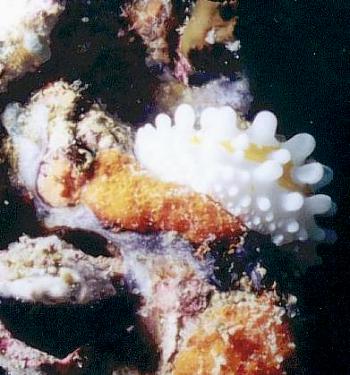
Hello.
I've spend 15 days of holidays in Koh Tao (Thailand), and I've seen many species of nudibranchs. Once returned home, I've been able to identify most of these species.
But I'm not sure about one of them. Maybe it is a Phyllidia ocellata? (I've seen a few others there). Is is about 3cm long. I have enclosed two photos of it [upper right, lower left] and one photo of what I think is really Phyllidia ocellata [lower right].
Can you confirm or else tell me what is this nudibranch, please?
Vincent Tomeno
vtomeno@cybercable.fr
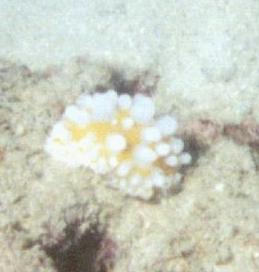
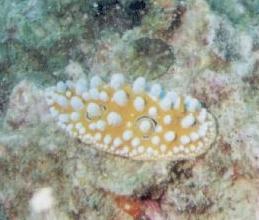
Dear Vincent,
Phyllidia ocellata is quite variable in colour but I am not sure whether the upper right and lower left photos are of a species of Phyllidia or not. The lower right photo is definitely P. ocellata.
I am afraid the only way to be sure would be to look at a specimen. If you have other photos perhaps you can check whether any of them shows a circle of gills. Your animal has similarities to Caldinella ornatissima which is quite variable in colour, but like most dorids has a circle of gills visible on the dorsal surface of the body.
Perhaps someone will recognise this animal for us. [See also David Harasti's message with probably the same animal].
Best wishes,
Bill Rudman.
Unknown phyllidiid with one rhinophore
August 13, 2000
From: Stuart Hutchison
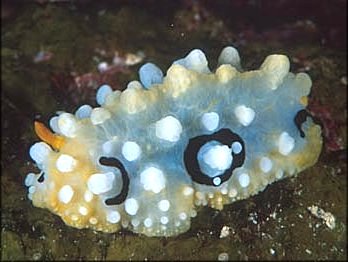
Dear Bill,
This phyllidiid was located by Melinda in about 6m on a coral bommie at Flinders Reef (Great Barrier Reef - Australia). It was about 50mm long.
I have looked pretty hard and I can't find any real sign of the second rhinophore. I have included a zoomed shot to make the check easier. Perhaps this is unusual?
Regards,
Stuart.
hutchco@tpg.com.au
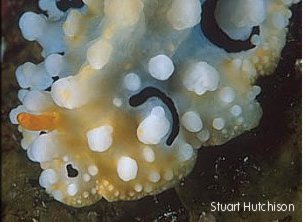

Dear Stuart,
Yes, one rhinphore is unusual. I am building up a page of abnormalities, such as this. Some are caused by developmental abnormalities and others are the result of damage and regrowth. I am not just what category your animal falls into. I first thought that the lack of colour on its left side was due to regrowth after an 'accident', but it looks like quite a bit of the body lacks the yellow background colour.
Paired sensory organs, like rhinophores, are important to the animal because they allow the slug to balance the intensity of 'smells' on both rhinophores and so detect the direction from which the smell has arisen. Clearly they can survive with only one rhinophore, but it may be quite difficult for these essentially sightless animals to function adequately when their main sensory system is damaged so funadmentally.
And before I forget, this is Phyllidia ocellata. Perhaps you could give me some idea of its size.
Best wishes,
Bill Rudman.
Phyllidia ocellata from New South Wales
June 12, 2000
From: Akos Lumnitzer
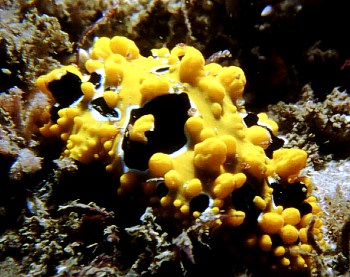
Dear Bill,
Here is a photo of Phyllidia ocellata from Fishrock, South West Rocks, northern New South Wales, September 1998, in 34 meters of water.
Akos
akos72@hotmail.com
Lumnitzer, A., 2000 (Jun 12) Phyllidia ocellata from New South Wales. [Message in] Sea Slug Forum. Australian Museum, Sydney. Available from http://www.seaslugforum.net/find/2551Thanks Akos,
Bill Rudman.
Phyllidia ocellata from the Marshall Ids
May 9, 2000
From: Scott Johnson
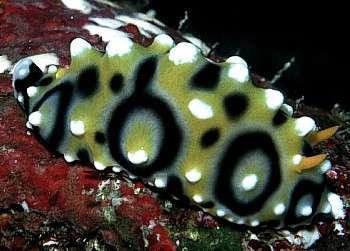
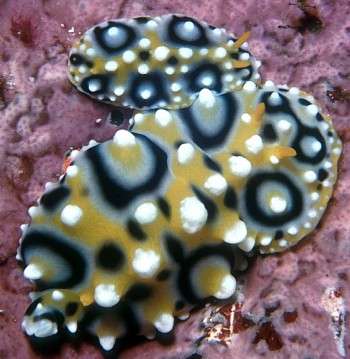
Hi Bill,
Here's the color form of Phyllidia ocellata from the Marshall Islands. So far I've seen only these two specimens of this species here.
Scott
johnson@kmr.ll.mit.edu
Johnson, S., 2000 (May 9) Phyllidia ocellata from the Marshall Ids. [Message in] Sea Slug Forum. Australian Museum, Sydney. Available from http://www.seaslugforum.net/find/2368Thanks Scott,
Bill Rudman.
Phyllidia ocellata? from Sulawesi
May 7, 2000
From: Lindsay Warren
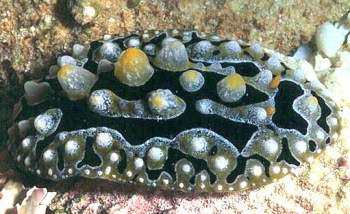
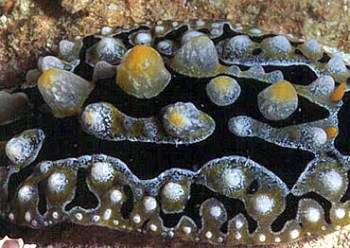
Dear Bill
This specimen was found by Iain McKeith on 29 July 1999 at a depth of 17 m on encrusting coral in a recessed part of a wall on Pulau Hoga [Tukang Besi Archipelago, SE Sulawesi, Indonesia - Operation Wallacea]. Size: 30 mm.
We have found other specimens of P. ocellata which were quite easy to identify. However this specimen posed a few questions: the orange areas on the notum are not as solid as I have seen in other photos; the black areas are very irregular; there are 3 particularly large orange-dusted pustules on the central notum. Photo: Lindsay Warren.
Is this a variant on P. ocellata, P. exquisita or another species?
All the best
Lindsay Warren.
alldcl@compuserve.com
Warren, L., 2000 (May 7) Phyllidia ocellata? from Sulawesi. [Message in] Sea Slug Forum. Australian Museum, Sydney. Available from http://www.seaslugforum.net/find/2366Dear Lindsay,
This is one of the colour forms of P. ocellata, almost identical to one figured by Brunckhorst [Pl 2, fig G]. A copy of Brunckhorst's Pl 2, fig G, is at the top of this page at bottom left.
The background colour is basically yellow or black. I have included an enlarged view of part of the animal to show all the microscopic white glands which secrete (or appear in the process od secreting) the distastteful antifeedant defensive chemicals it obtains from its sponge food.
Best wishes,
Bill Rudman.
Phyllidia ocellata from South Africa
March 21, 2000
From: Valda Fraser
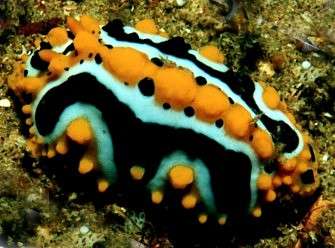
Dear Bill
I think this is Phyllidia ocellata, but I'd like to make sure.
Thanks.
Locality: South Coast KwaZulu-Natal, SOUTH AFRICA. Scottburgh - 25m
Date: October 1999
Size: 40mm
Regards
Valda Fraser
iti04937@mweb.co.za
dear Valda,
This is a colour variation was considered to be a distinct geographical subspecies by Yonow (1986) and she named it Phyllidia ocellata undula, on the grounds that it was endemic to the Red Sea [see Right-Lower photo at Top of Page].
However Brunckhorst, 1993) reported the same colour form from many parts of the Indo-West Pacific and so considered the subspecies name unnecessary.
Best wishes,
Bill Rudman.
Phyllidia ocellata from New South Wales
March 12, 2000
From: Erik Schloegl
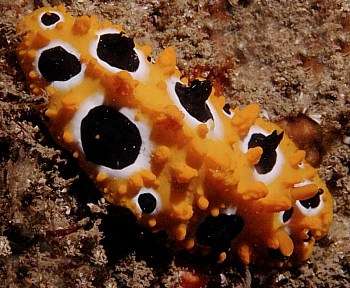
Dear Bill,
Here's a photo of Phyllidia ocellata taken on September 9, 1998 at Fish Rock (a small rock island near Southwest Rocks on the northern New South Wales coast). The depth was 32m, the substrate rocky reef. Is this near the southern limit for the distribution of this species?
Best regards,
Erik Schloegl.
schloegl@maths.uts.edu.au
Schloegl, E., 2000 (Mar 12) Phyllidia ocellata from New South Wales. [Message in] Sea Slug Forum. Australian Museum, Sydney. Available from http://www.seaslugforum.net/find/2070Dear Erik,
The southern limit on the eastern Australian coast for most tropical species is very variable, depending on the physical conditions (southerly currents, water temp etc.) and biological factors such as presence of their food, sufficient larvae etc.
Green Cape at the border between new South Wales and Victoria is one of the few political boundaries any where in the world which is also a pretty good biological boundary. Certainly both the fish and mollusc fauna noticeably change there. So to answer your question, I don't know of many records of P. ocellata in New South Wales, but I suspect if I say yours is the most southerly I have heard of someone will send us a photo from Wollongong or somewhere else further souht.
Cheers,
Bill Rudman.
Phyllidia ocellata from Philippines
January 17, 1999
From: Erwin Koehler

Here is Phyllidia ocellata (Cuvier, 1804), Pamilacan Is., Philippines, Nov. 1998.
Erwin
E.Koehler@deutschepost.de
Koehler, E., 1999 (Jan 17) Phyllidia ocellata from Philippines. [Message in] Sea Slug Forum. Australian Museum, Sydney. Available from http://www.seaslugforum.net/find/481This is quite a good photo showing the anti-predator secretions exuding out of the tubercles. The milky-white film over the tubercles is a thick secretion from mantle glands.
Bill Rudman.
